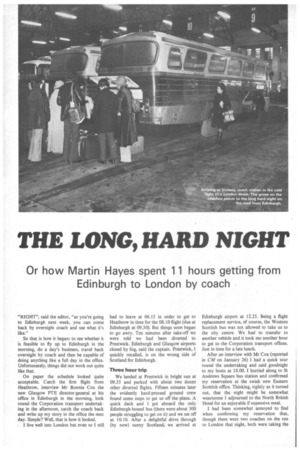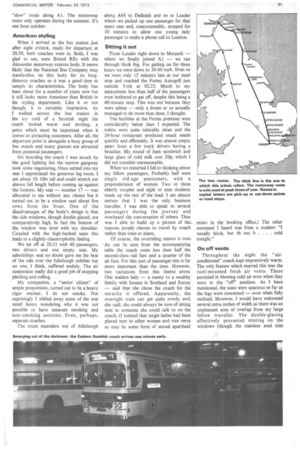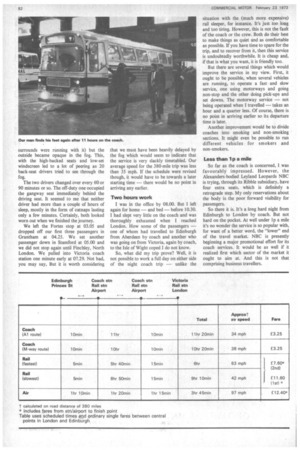THE LONG, HARD NIGHT
Page 50

Page 51

Page 52

If you've noticed an error in this article please click here to report it so we can fix it.
Or how Martin Hayes spent 11 hours getting from Edinburgh to London by coach
"RIGHT", said the editor, "as you're going to Edinburgh next week, you can come back by overnight coach and see what it's like."
So that is how it began: to see whether it is feasible to fly up to Edinburgh in the morning, do a day's business, travel back overnight by coach and then be capable of doing anything like a full day in the office. Unfortunately, things did not work out quite like that.
On paper the schedule looked quite acceptable. Catch the first flight from Heathrow, interview Mr Ronnie Cox the new Glasgow PTE director-general at his office in Edinburgh in the morning, look round the Corporation transport undertaking in the afternoon, catch the coach back and write up my story in the office the next day. Simple? Well, that is how it looked.
I live well into London but even so I still had to leave at 06.15 in order to get to Heathrow in time for the 08.10 flight (due at Edinburgh at 09.30). But things soon began to go awry. Ten minutes after take-off we were told we had been diverted to Prestwick. Edinburgh and Glasgow airports closed by fog, said the captain. Prestwick, I quickly recalled, is on the wrong side of Scotland for Edinburgh.
Three hour trip
We landed at Prestwick in bright sun at 09.35 and parked with about two dozen other diverted flights. Fifteen minutes later the evidently hard-pressed ground crew found some steps to get us off the plane. A quick dash and I got aboard the only Edinburgh-bound bus (there were about 300 people struggling to get on it) and we set off at 10.10. After a delightful drive through (by now) sunny Scotland, we arrived at Edinburgh airport at 12.25. Being a flight replacement service, of course, the Western Scottish bus was not allowed to take us to the city centre. We had to transfer to another vehicle and it took me another hour to get to the Corporation transport offices. Just in time for a late lunch.
After an interview with Mr Cox (reported in CM on January 26) I had a quick tour round the undertaking and said goodnight to my hosts at 18.00. I hurried along to St Andrews Square bus station and confirmed my reservation at the swish new Eastern Scottish office. Thinking, rightly as it turned out, that the night might be somewhat wearisome I adjourned to the North British
• Hotel for an enjoyable if expensive meal.
I had been somewhat annoyed to find when confirming my reservation that, though there were two coaches on the run to London that night, both were taking the
"slow" route along Al. The motorway route only operates during the summer. It's one hour quicker.
American styling When I arrived at the bus station just after eight o'clock, ready for departure at 20.30, both coaches were in. Both, I was glad to see, were Bristol REs with the Alexander motorway express body. It seems likely that the National Bus Company may standardize on this body for its longdistance coaches so it was a good time to sample its characteristics. The body has been about for a number of years now but it still looks more American than British in the styling department. Like it or not though, it is certainly impressive. As I walked across the bus station in the icy cold of a Scottish night the coach looked warm and inviting, a point which must be important when it comes to attracting customers. After all, the departure point is alongside a busy group of bus stands and many glanced are attracted from potential passengers.
On boarding the coach I was struck by the good lighting but the narrow gangway took some negotiating. Once settled into my seat I appreciated the generous leg room. I am about 5ft 10in tall and could stretch out almost full length before coming up against the footrest. My seat — number 17 — was allocated to me without any choice but it turned out to be a window seat about five rows from the front. One of the disadvantages of the body's design is that the side windows, though double-glazed, are comparatively high. In fact the bottom of the window was level with my shoulder. Coupled with the high-backed seats this leads to a slightly claustrophobic feeling.
We set off at 20.35 with 40 passengers, two drivers and one empty seat. My admidships seat no doubt gave me the best of the ride over the Edinburgh cobbles but no one, I think, suffered unduly. The air suspension really did a good job of stopping pitching and rolling.
My companion, a "senior citizen" of ample proportions, turned out to be a heavy cigar smoker. I do not smoke. Not suprisingly I whiled away some of the wee small hours wondering why it was not possible to have separate smoking and non-smoking sections. Even, perhaps, separate coaches.
The route meanders out of Edinburgh along A68 to DaLkeith and on to Lauder where we picked up one passenger for that spare seat and, unaccountably, stopped for 10 minutes to allow one young lady passenger to make a phone call to London.
Sitting it out From Lauder right down to Morpeth — where we finally joined Al — we ran through thick fog. For getting on for three hours we were down to 30-40 mph. Even so we were only 15 minutes late at our meal stop and reached the Fortes Autogrill just outside York at 02.25. Much to my amazement less than half of the passengers even bothered to get off, despite this being a 40-minute stop. This was not because they were asleep — only a dozen or so actually managed to do more than doze, I thought.
The facilities at the Fortes premises were considerably better than I expected. The toilets were quite tolerably clean and the 24-hour restaurant produced snack meals quickly and efficiently. It was almost empty apart from a few truck drivers having a breather. My round of ham sandwich and large glass of cold milk cost 20p, which I did not consider unreasonable.
When we restarted I fell to thinking about my fellow passengers. Probably half were single old-age pensioners, with a preponderance of women. Two or three elderly couples and eight or nine students
• made up the rest of the load. I am almost certain that I was the only business traveller. I was able to speak to several passengers during the journey and overheard the conversation of others. Thus was I able to build up a picture of the reasons people choose to travel by coach rather than train or plane.
Of course, the overriding reason is cost. As can be seen from the accompanying table the coach costs less than half the second-class rail fare and a quarter of the air fare. For this sort of passenger this is far more important than the time. However, two variations from this theme arose. One maiden lady — a nanny to a wealthy family with houses in Scotland and Surrey — said that she chose the coach for the security it offered. Apparently, the overnight train can get quite rowdy and, she said. she could always be sure of sitting next to someone she could talk to on the coach. (I noticed that single ladies had been placed next to other women and vice versa so may be some form of sexual apartheid exists in the booking office.) The other comment I heard was from a student: "I
usually hitch, but it too b . . cold tonight."
On off vents Throughout the night the "airconditioned" coach kept impressively warm. The only feature which marred this was the roof-mounted fresh air vents. These persisted in blowing cold air even when they were in the "off" position. As I have mentioned, the seats were spacious so far as the legs were concerned — even when fully reclined. However, I would have welcomed several extra inches of width as there was an unpleasant area of overlap from my large fellow traveller. The double-glazing effectively, prevented misting on the windows (though the stainless steel. trim
surrounds were running with it) but the outside became opaque in the fog. This, with the high-backed seats and low-set windscreen led to a lot of peering as 20 back-seat drivers tried to see through the fog.
The two drivers changed over every 60 or 90 minutes or so. The off-duty one occupied the gangway seat immediately behind the driving seat. It seemed to me that neither driver had more than a couple of hours of sleep, mostly in the form of catnaps lasting only a few minutes. Certainly, both looked worn out when we finished the journey.
We left the Fortes stop at 03.05 and dropped off our first three passengers in Grantham at 04.25. We set another passenger down in Stamford at 05.00 and we did not stop again until Finchley, North London. We pulled into Victoria coach station one minute early at 07.29. Not bad, you may say, But it is worth considering that we must have been heavily delayed by the fog which would seem to indicate that the service is very slackly timetabled. Our average speed for the 380-mile trip was less than 35 mph. If the schedule were revised though, it would have to be towards a later starting time — there would be no point in arriving any earlier.
Two hours work I was in the office by 08.00. But I left again for home — and bed — before 10.30. I had slept very little on the coach and was thoroughly exhausted when I reached London. How some of the passengers — one of whom had travelled to Edinburgh from Aberdeen by coach and another who was going on from Victoria, again by coach, to the Isle of Wight coped I do not know.
So, what did my trip prove? Well, it is not possible to work a full day on either side of the night coach trip — unlike the situation with the (much more expensive) rail sleeper, for instance. It's just too long and too tiring. However, this is not the fault of the coach or the crew. Both do their best to make things as quiet and as comfortable as possible. If you have time to spare for the trip, and to recover from it, then this service is undoubtedly worthwhile. It is cheap and, if that is what you want, it is friendly too.
But there are several things which would improve the service in my view. First, it ought to be possible, when several vehicles are running, to operate a fast and slow service, one using motorways and going non-stop and the other doing pick-ups and set downs. The motorway service — not being operated when I travelled — takes an hour and a quarter less. Of course, there is no point in arriving earlier so its departure time is later.
Another improvement would be to divide coaches into smoking and non-smoking sections. It might even be possible to run different vehicles for smokers and non-smokers.
Less than 1 p a mile So far as the coach is concerned, I was favourably impressed. However, the Alexanders-bodied Leyland Leopards NBC is trying, through its Ribble subsidiary, have four extra seats, which is definitely a retrograde step. My only reservations about the body is the poor forward visibility for passengers.
So there it is. It's a tong hard night from Edinburgh to London by coach. But not hard on the pocket. At well under lp a mile it's no wonder the service is so popular with, for want of a better word, the "lower" end of the travel market. NBC is presently beginning a major promotional effort for its coach services. It would be as well if it realized first which sector of the market it ought to aim at. And this is not that comprising business travellers.
































































































